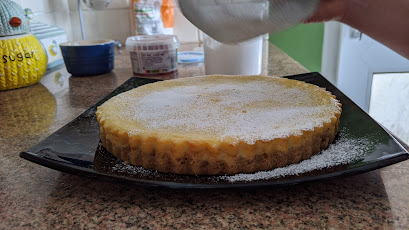Spain 2020
This week Heidi took complete control. The results are promising, and I'll have to let her lead more from now onwards.
She baked Greixonera de Heidi.
A stodgy lemon and cinnamon cheesecake from Mallorca.
The website from which we stole the recipe calls it 'ricotta casserole'. I feel this is somewhat lost in translation, but it certainly doesn't give it the appeal that I look for in a cake. Maybe letting Heidi choose was less than genius.
The real Spanish name is Greixonera de brossat, which Google Translate tells us means 'brushing grease'. I suspect there's a history behind that, which we'd rather not know, and you have no interest in hearing me recall either.
Though this year we have been making our unique alterations to ruin these classic cakes, we have barely changed this recipe. We think that the Italian ricotta is actually not exactly right, but that's the closest thing available in our supermarkets. The biscuit base should be made with traditional María biscuits, which are fundamentally a perversion of a good old rich tea. But that would make a bland dry base, so we improvised with digestives glued with a little melted butter. And before I have a flood of complaints about how non-traditional the use of butter is for a Spanish cake, let me point out that this is the genuine recipe for Greixonera de Heidi (recipe defined below).
The end result is a slightly warm (we couldn't wait any longer) custard on stodgy dense base. Apparently, you can tip it up to serve upside down, but I suspect that is rather the result of an ancient accident than intensional.
Heidi topped with icing sugar and glace cherries (who would have guessed?!). The lemon and cinnamon were too mild to taste.
Sian pulled the same face that she does with my cooking.
 |
| The point at which I realised, Heidi had proceeded to get on with baking without me. By which time, the milk had been sweetened and flavoured, the ricotta mushed and the two combining. |
 |
| Sloppy cheese is dribbled over digestive biscuits |
 |
| Flan dish firmly secured to the baking tray |
 |
| Icing sugar topping |
 |
| Enjoy with a glass of milk on a wet August afternoon |
Recipe for those of you daring enough to try
Ingredients
- 500g of ricotta cheese
- 6 eggs
- 150g sugar
- 245g of full-fat milk
- Cinnamon (left to herself, the quantity used is an unknown shake of the jar)
- Zest of half a lemon (or more if you want to taste it)
- About 10 digestive biscuits
- 50g butter
- Sprinkling of icing sugar
- 6 glace cherries
Method
- In a saucepan, gently warm the milk, sugar, cinnamon and lemon zest until the sugar dissolves, Leave to cool.
- Preheat the oven to Gas Mark 2/150C - or not work out that this necessary until later.
- Mash (or whisk if you're that way inclined) eggs and ricotta in a bowl
- Pour in the milk mixture elegantly
- Melt the butter, crush the digestives to crumbs and combine.
- Place the biscuit into the base of a flan dish and press down to even out. Pour the milk/egg/cheese mix over, leaving some space for it to rise.
- Determine that the quantity left is too much to discard and make some individual portions in whatever ramekin dishes you have available.
- Realise that the runny milky, eggy, cheese slop is now leaking through the loose bottom flan dish and running over the work surface. Quickly place onto a baking tray with edges and get it into the oven. The mixture will continue to leak out in the oven, but this is part of the authentic recipe.
- Cook for somewhere around 45 mins until the mixture leaves a toothpick almost clean, when stabbed through the middle, and/or you can't be bothered to wait any longer.
- Leave to mostly cool and hopefully set.
- Precariously separate the flan dish from the baking tray and the cake from the flan dish, detaching the sealed sugar edges.
- Top with a dainty dusting of icing sugar and cherries.


Comments
Post a Comment